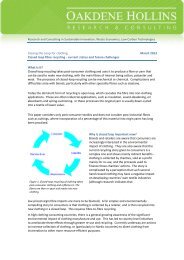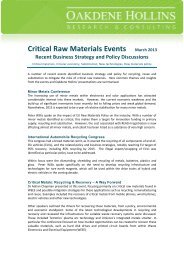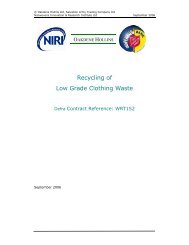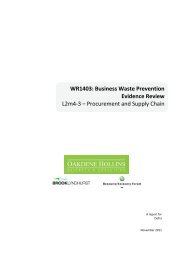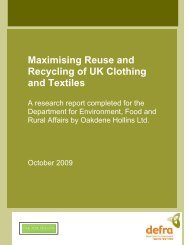Fire Retardant Technologies: safe products with ... - Oakdene Hollins
Fire Retardant Technologies: safe products with ... - Oakdene Hollins
Fire Retardant Technologies: safe products with ... - Oakdene Hollins
- No tags were found...
You also want an ePaper? Increase the reach of your titles
YUMPU automatically turns print PDFs into web optimized ePapers that Google loves.
18. Investigate the use of graphite impregnated foam in the domestic marketPhysical fire protection of foam seating by the introduction of graphite impregnated foam(GIF) as an inherently fire-resistant foam is widely used in aircraft and other masstransport systems. GIF-foams may be recommended as the best environmentalperforming technology but concerns exist on potential cost implications. They also havea need for additional chemical FRs to assist gas phase retardancy.19. Investigate replacing halogenated phosphorus FRs <strong>with</strong> non-halogenatedphosphorus FRsIn regard to chemical FR technologies, the halogenated phosphorus based FRchemicals currently used for fire retarding foams could be replaced by non-halogenatedphosphorus based fire retardant, such as triarylphosphate, organic phosphate ester <strong>with</strong>triphenyl phosphate. Whichever alternative chemical FRs are considered, their hazardand risk assessment and CLP status would need to be reviewed.However, it is noted these are additive FRs and are not reactive. While some may beable to satisfy the Ecolabel risk phrase criteria they would be excluded because of notbeing reactive. So the “additive” constraint is unacceptable as no conventionalpolyurethane foams could satisfy this requirement. Also, in regard to GPP, a move tonon-chlorinated FRs would increase costs and in some cases substantially so.20. Review and continue to develop nanocomposite foams as an alternative toconventional polyurethane foamsThere has been a considerable amount of research in developing polymernanocomposite foams, but current findings suggests they still need other fire retardantto adequately pass fire performance tests. However, most of the effort to date has beenat a laboratory scale and are not yet commercially available. So while this can rightly beseen as an emerging technology it is unlikely to provide the required degree of fireretardancy on its own <strong>with</strong>out the aid of other FRs. The benefit is the potential reductionin the amount of chemical FR used. Review and continue to develop nanocompositefoams as an alternative to conventional polyurethane.21. Most FR foams for interior furnishings rely currently on additive chemical andphysical FR technologies, including those that would satisfy R-phrase criteria. The“additive” FR criteria should not apply to foams unless viable alternatives areavailable.Interior Furnishings22. Use inherent fire retardant materials where possibleInherent FR approaches are possible for many textiles, for example the use of modifiedacrylic/cotton blends (i.e. a partially inherently FR blend) was used in the USA, albeit<strong>with</strong> different regulatory requirements. There is also some use of inherently FR polyesterand wool or wool blends in coverings. These provide opportunities to use inherent FRmaterials options but they may be seen as limited <strong>with</strong>in the current vast range ofmaterials and constructions currently available.23. Allow use of synthetic, inherently fire retardant interlinersTechnically, interliners may be used as a design alternative to eliminate chemical FRuse. Consultation <strong>with</strong> users revealed a view that they may be of limited use in gainingenvironmental improvement since it is believed that most interliners in the UK were ofP a g e 22 |




